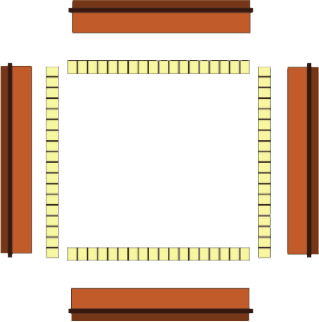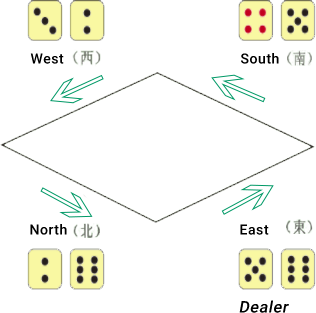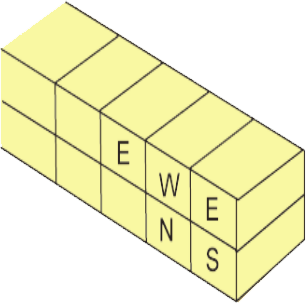
|
American Mah-Jongg (NMJL) |
Modern American Mah Jongg dates to the 1920's - the publication of the book by Joseph Babcock "Rules of Mah-Jongg." American mahjong (also sometimes spelled "Mah Jongg" or "Maajh") differs from Asian mahjong:
American Mah-Jongg uses:
- Racks and jokers
- "Hands and Rules" scorecard from NMJL (National Mah-Jongg League)
- Several distinct gameplay mechanics, such as "Charleston"
Tiles
Your mahjong set has 166 tiles. 152 are used in play and the rest are spares.
The 152 tiles are divided into four groups with their subgroups:
1. SUITS (108 tiles)
Circles or Dots(36 tiles - 4 of each)

Bamboos or Bams(36 tiles - 4 of each)

Characters or Craks(36 tiles - 4 of each)

2. HONORS (28 tiles)
Winds (16 tiles - 4 East wind, 4 South wind, 4 West wind, 4 North wind)

Dragons(12 tiles - 4 white dragons "Soap", 4 Green dragons, 4 red dragons). The white dragon tile on the left is also known as "Soap". Soaps can be used as zeroes when putting together certain hands.

3. FLOWERS and SEASONS (8 tiles - 1 of each)


4. JOKERS or Wild Tiles (8 tiles - all identical)
Jokers can substitute for any tile in a Pung (3 identical tiles), Kong (4 identical tiles), Quint (5 identical tiles) or Sextet (6 identical tiles). They cannot be used to substitute a tile in a Pair (2 identical tiles) or any single tile.

Starting The Game
Build the Walls. Each player builds a wall of tiles two tiles high in front of her rack as shown in the diagram below using all 152 tiles. Each wall consists of two rows of 19 tiles.

Determining Who is East. Each player roles the dice in turn. The player with the highest number becomes East (dealer). The player to her right is South, followed by West and then North.

Break the Wall. East rolls the dice and then counts off the resulting number from the stack of tiles in front of her, from right to left, and breaks the wall. For example, if East rolls an eight, East will separate eight groups of two tiles from the right end of the wall. Then, East takes the following four tiles (two from the top row and two from the bottom row).
Moving counter-clockwise, each player then takes turns where the dealer left off, taking four tiles (two from the top and two from the bottom) for herself. The process continues until each player has 12 tiles.
When all players have 12 tiles, East (the dealer) takes two additional tiles - the first and third tile from the top row (as shown below). This gives her 14 tiles. Moving counter-clockwise, the other players take one tile from the end (as shown below), giving each of them a total of 13 tiles.

Picking a Hand
Now the strategizing begins. Each player arranges the tiles on her rack in a logical order so she can start to realize her goal of putting together her mahjong hand. The goal of mahjong is to match your tiles exactly with a hand from the score card.
How To Read The Score Card
The hands on a score card are represented in numbers or letters in either red, blue, or green. The colors are not specific to any one suit, and different colors simply mean different suits have to be used. Flowers and zeroes are not considered to be part of any suit and will always be blue.
| 1-9 | Correspond to the speicifc number on the tile (not including flowers) |
|---|---|
| N,S,E,W | North, South, East, West |
| D | Dragon |
| R | North, South, East, West |
| G | Green Dragon |
| 0 | White Dragon (Soap) |
| F | Flower |
The score card is organized into categories for hands based on common patterns:
| YEAR | Patterns that make up a year, such as 2010. In such case 2's, 0's, and 1's would be used. White dragons are always used as zeros. |
|---|---|
| 2468 | Patterns that require even numbered tiles. |
| Change-up | This section varies |
| Quints | Hands that have at least one quint (5 indentical tiles) where at least one of which is a Joker. |
| Consecutive Runs | Patterns of consecutive numbers. |
| 13579 | Patterns that require odd numbered tiles. |
| Winds-Dragons | Patterns requiring wind and dragon tiles. |
| 369 | Patterns using 3's, 6's, and 9's. |
| Singles and Pairs | Patterns with single and paired tiles. |
Each hand is grouped into several different combinations. Some combinations contain non-matching tiles, but most generally have two or more matching identical tiles. These are known as:
| Pair | Two identical tiles. |
| Pung | Three identical tiles. |
| Kong | Four identical tiles. |
| Quint | Five identical tiles, with the use of Jokers. |
| Sextet | Six identical tiles, with the use of Jokers. |
Next to each hand is the value of the hand for scoring or gambling purposes. Next to the hand is an 'X' or a 'C' indicating whether that hand is exposed or concealed (explained later):
| X | Exposed |
|---|---|
| C | Concealed |
The Charleston
Before actual play starts, it's time for The Charleston...
The Charleston is a ritual unique to American mahjong with roots to its beginnings in the early 1920's. It is an exchange of tiles that gives each player a chance to improve her hand by passing unwanted tiles face down to other players.
| 1 | Each player passes 3 unwanted tiles to the player to her right. |
|---|---|
| 2 | Each player passes 3 unwanted tiles to the player opposite her. |
| 3 | Each player passes 3 unwanted tiles to the player to her left, known as 'first left'. The player is allowed to 'blind pass' up to three tiles. A blind pass is taking the tiles received and passing them without looking at them. |
The Charleston may proceed a second time if all the players agree. The second Charleston proceeds in the following sequence:
| 1 | Each player passes 3 unwanted tiles to the player to her left. |
|---|---|
| 2 | Each player passes 3 unwanted tiles to the player opposite her. |
| 3 | Each player passes 3 unwanted tiles to the player to her right, known as 'last right'. The player may blind pass these tiles. |
At the end of the second Charleston, a player may make an optional 'courtesy pass'. The player may agree with the player across from her to exchange up to three tiles.
No jokers may be passed during the Charleston and courtesy pass.
During the Charleston you may want to change the hand you are aiming for. As tiles are exchanged you may discover another hand might be more ideal than the original one you had in mind.
Gameplay
The goal of each player is to win the game by being the first person to declare "Mahjong" by correctly creating a hand that exactly matches a hand on the score card.
Drawing and discarding tiles
Now the excitement begins as each player tries to improve her hand. Since East has 14 tiles, she starts the game by discarding a tile. If the discarded tile is not called (claimed by other players), the turn continues to the next player on the right. The next player draws a tile from the wall. The tile is taken from where the breaking of the walls was left off. When a player draws a tile from the wall, she takes the top tile if the next tile in the stack is two tiles high, otherwise she takes the bottom tile.
The player either decides to discard the drawn tile or to place it in her hand and then discard another tile from her hand. The name of the discarded tile is announced and placed face up in the center of the table. Caution must be used here since each tile you discard is seen by the other players and it won't be long before they figure out what kind of hand you are trying to build.
If the discardeed tile is not called, the turn continues to the next player on the right. The sequence of drawing, discarding, and continuing turns is repeated unless interupted by a call.
Calling Tiles
The most recent discard may be called by any player if the tile completes a pung, kong, quint, sextet, or another combination of an exposed hand (a hand marked with "X" next to its value on the score card).
- A tile may not be called to complete a combination of the hand that requires only a single tile.
- A tile may not be called to complete a pair unless it completes a mahjong hand.
- Tiles discarded prior to the most recent cannot be called and are dead tiles.
If a player calls to take a discarded tile and it does not result in mahjong, the combination it completes must be exposed face up on top of their rack for everyone to see and cannot be changed for the rest of the game. The player then discards a tile and if it isn't called by another player, the turns continue with the player to the right. Note that some players may have their turns skipped when a tile is called.
There are provisions when more than one person calls:
- The player who calls a tile to complete a mahjong hand trumps calls by any other player to complete a set.
- When none of the calls are to complete a mahjong hand, the player nearest in turn receives the discard.
Note: When aiming for a concealed hand (a hand marked with a "C" next to its value on the scorecard), all of the tiles in your hand must be drawn from the wall. None of them may be called tiles except for the last tile which would allow you to declare Mahjong.
Joker Rules
Jokers can substitute any tile in a pung, kong, quint or sextet combination. They may not be used to complete a pair or single tiles in a hand.
If a player has an exposed combination with a joker substituting a tile and you have the actual tile the joker is substituting, you may exchange that tile for the joker in the following manner:
- Call a discard or draw a tile from the wall on your turn as you normally would.
- Exchange the actual matching tile with the exposed substituting joker. Multiple matching tiles may be exchanged for multiple exposed jokers.
- Discard a tile to maintain the proper tile count in your hand. After exchanging for a joker, it is not necessary to expose tiles if that joker creates a combination in your hand. Jokers exposed in dead hands (hands that are out of the game due to violating rules), may be exchanged.
Ending The Game
The game ends when either someone declares "mahjong" or when there are no more tiles in the wall to be drawn.
Mahjong
When a 14th tile drawn from the wall or called from a discard completes a hand on the score card, a mahjong is created. The player then declares "Mahjong" and wins the game.
The payout to the winner is based on the value of the hand and how the mahjong was created:
| TYPE OF MAHJONG | PAYOUT |
|---|---|
| Mahjong made off a discard. value. | Discarder pays the winner double the value of the hand. All other players pay single |
| Mahjong made off a draw from the wall. | Each player pays double the value of the hand. |
| Mahjong made off a discard, contains no jokers, and is not from the Singles and Pairs category. | Discarder pays the winner four times the value of the hand. All other players pay double value. |
| Mahjong made off a draw from the wall, contains no jokers, and is not from the Singles and Pairs category. | Each player pays four times the value of the hand. |
Draw
If mahjong has not been called and all the tiles have been drawn from the wall and the last discard has been made then the game ends in a draw. No payouts are made.
After The First Game
Now that the first game is complete, the position of East (dealer) moves to the person on their right. After each game, the position of East continues to move counter-clockwise. The process of shuffling the tiles, rebuilding the walls, and dealing is repeated until the games end.